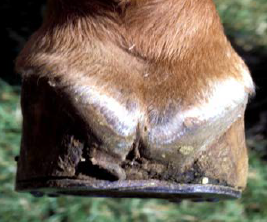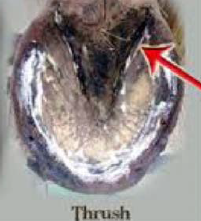Equine podiatry
Thrush
Dr. F Tóth notes
Definition
Thrush -Degenerative condition of the frog & surrounding tissues caused by infection with keratolytic organisms
Etiology
Fusobacterium necrophorum appears to be the most important organism. This opportunistic organism can thrive with poor sanitation or persistent wet conditions. External risk factors include sole pads that keep the sole moist, confinement and muddy paddocks. Horse risk factors include poor conformation with deep frog sulci and/or sheared heels (image below).

Clinical signs
Thrush is characterized by black, necrotic, foul-smelling material in central sulcus or collateral sulci of frog. Generally the infection is restricted to the frog and sulci but it can involve the digital cushion and skin at the heel bulbs.

The infection leads to deep sulci and eventually an atrophied frog. If the sensitive tissues (beyond the frog) are involved, lameness may be present.
Treatment
- Clean feet daily
- Remove necrotic tissue
- Apply drying agent to foot
- Foot soaks in chlorine bleach [30 mL (1 oz) of bleach in 5L water]
- Miconazole (Lotrimin) plus neomycin (50/50 mixture)
- Bandage (if needed for protection)
- Trim foot (if indicated)
- Improve sanitation (if indicated)
Prognosis
Good for full recovery
Key Takeaways
Wet feet with deep frog crevices get thrush.
- Foul smelling, black gunk in frog
- Occurs due to excessive moisture
- Dry the foot and treat with various compounds
Resources
Thrush in horses, Merck Manual

